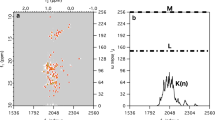Abstract
We present SARA (Software for Accordion Relaxation Analysis), an interactive and user-friendly MATLAB software environment designed for analyzing relaxation data obtained with accordion spectroscopy. Accordion spectroscopy can be used to measure nuclear magnetic resonance (NMR) relaxation rates in a fraction of the time required by traditional methods, yet data analysis can be intimidating and no unified software packages are available to assist investigators. Hence, the technique has not achieved widespread use within the NMR community. SARA offers users a selection of analysis protocols spanning those presented in the literature thus far, with modifications permitting a more general application to crowded spectra such as those of proteins. We discuss the advantages and limitations of each fitting method and suggest a protocol combining the strengths of each procedure to achieve optimal results. In the end, SARA provides an environment for facile extraction of relaxation rates and should promote routine application of accordion relaxation spectroscopy.







Similar content being viewed by others
References
Akke M, Brüschweiler R, Palmer AG (1993) NMR order parameters and free energy: an analytical approach and its application to cooperative calcium (2+) binding by calbindin D9 k. J Am Chem Soc 115:9832–9833
Barkhuijsen H, DeBeer R, VanOrmondt D (1987) Improved algorithm for noniterative time-domain model fitting to exponentially damped magnetic resonance signals. J Magn Reson 557:553–557
Bodenhausen G (1982) Direct determination of rate constants of slow dynamic processes by two-dimensional “accordion” spectroscopy in nuclear magnetic resonance. J Am Chem Soc 3:1304–1309
Bodenhausen G, Ernst R (1981) The accordion experiment, a simple approach to three-dimensional NMR spectroscopy. J Magn Reson 45:367–373. doi:10.1016/0022-2364(81)90137-2
Carr PA, Fearing DA, Palmer AG (1998) 3D accordion spectroscopy for measuring 15 N and 13CO relaxation rates in poorly resolved NMR spectra. J Magn Reson 132:25–33. doi:10.1006/jmre1998.1374
Chen K, Tjandra N (2009) Direct measurements of protein backbone 15 N spin relaxation rates from peak line-width using a fully-relaxed Accordion 3D HNCO experiment. J Magn Reson 197:71–76. doi:10.1016/j.jmr.2008.12.001
Delaglio F, Grzesiek S, Vuister GW et al (1995) NMRPipe: a multidimensional spectral processing system based on UNIX pipes. J Biomol NMR 6:277–293
Eisenmesser EZ, Millet O, Labeikovsky W et al (2005) Intrinsic dynamics of an enzyme underlies catalysis. Nature 438:117–121. doi:10.1038/nature04105
Guenneugues M, Gilquin B, Wolff N et al (1999) Internal motion time scales of a small, highly stable and disulfide-rich protein: a 15 N, 13C NMR and molecular dynamics study. J Biomol NMR 14:47–66
Gunther U, Ludwig C, Ruterjans H (2000) NMRLAB-advanced NMR data processing in matlab. J Magn Reson 145:201–208. doi:10.1006/jmre 2000.2071
Henzler-Wildman KA, Thai V, Lei M et al (2007) Intrinsic motions along an enzymatic reaction trajectory. Nature 450:838–844. doi:10.1038/nature06410
Herman P, Lee JC (2012) The advantage of global fitting of data involving complex linked reactions. In: Fenton AW (ed) Allostery. Springer New York, New York, pp 399–421
Korzhnev DM, Kay LE (2008) Probing invisible, low-populated States of protein molecules by relaxation dispersion NMR spectroscopy: an application to protein folding. Acc Chem Res 41:442–451. doi:10.1021/ar700189y
Mandel AM, Palmer AG (1994) Measurement of relaxation-rate constants using constant-time accordion NMR spectroscopy. J Magn Reson, Ser A 110:62–72. doi:10.1006/jmra1994.1182
Rabier P, Kieffer B, Koehl P, Lefèvre J-F (2001) Fast measurement of heteronuclear relaxation: frequency-domain analysis of NMR accordion spectroscopy. Magn Reson Chem 39:447–456. doi:10.1002/mrc.870
Sugase K, Dyson HJ, Wright PE (2007) Mechanism of coupled folding and binding of an intrinsically disordered protein. Nature 447:1021–1025. doi:10.1038/nature05858
Wand AJ (2013) The dark energy of proteins comes to light: conformational entropy and its role in protein function revealed by NMR relaxation. Curr Opin Struct Biol 23:75–81. doi:10.1016/j.sbi.2012.11.005
Acknowledgments
This work was supported by NIH, Grant R01-GM104257.
Author information
Authors and Affiliations
Corresponding author
Electronic supplementary material
Below is the link to the electronic supplementary material.
Rights and permissions
About this article
Cite this article
Harden, B.J., Frueh, D.P. SARA: a software environment for the analysis of relaxation data acquired with accordion spectroscopy. J Biomol NMR 58, 83–99 (2014). https://doi.org/10.1007/s10858-013-9807-x
Received:
Accepted:
Published:
Issue Date:
DOI: https://doi.org/10.1007/s10858-013-9807-x




